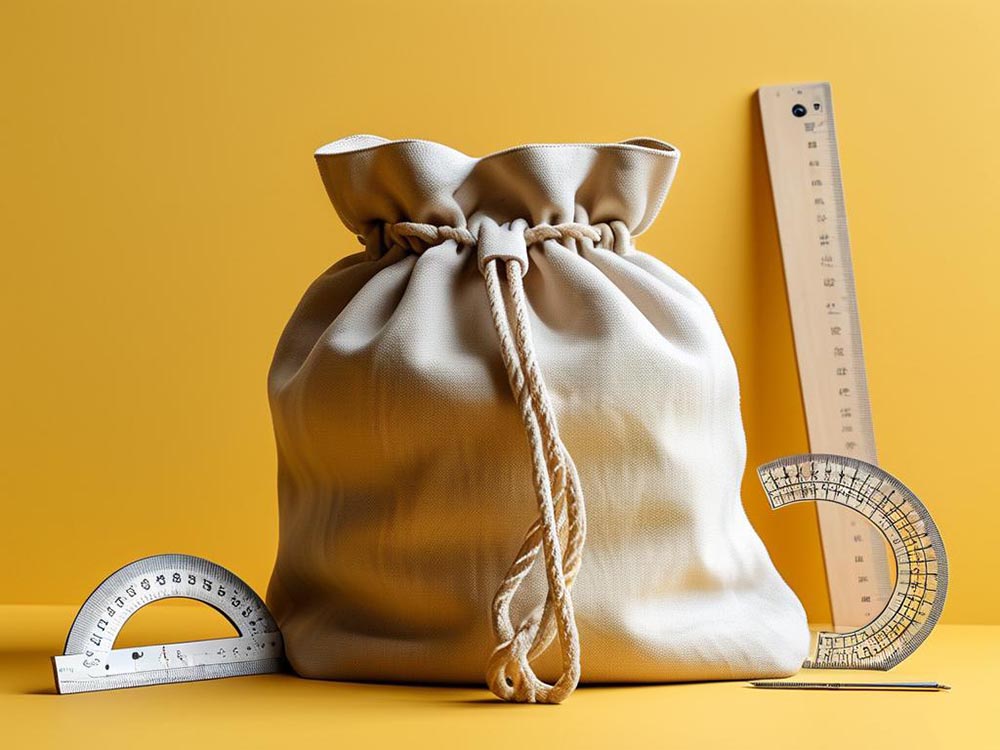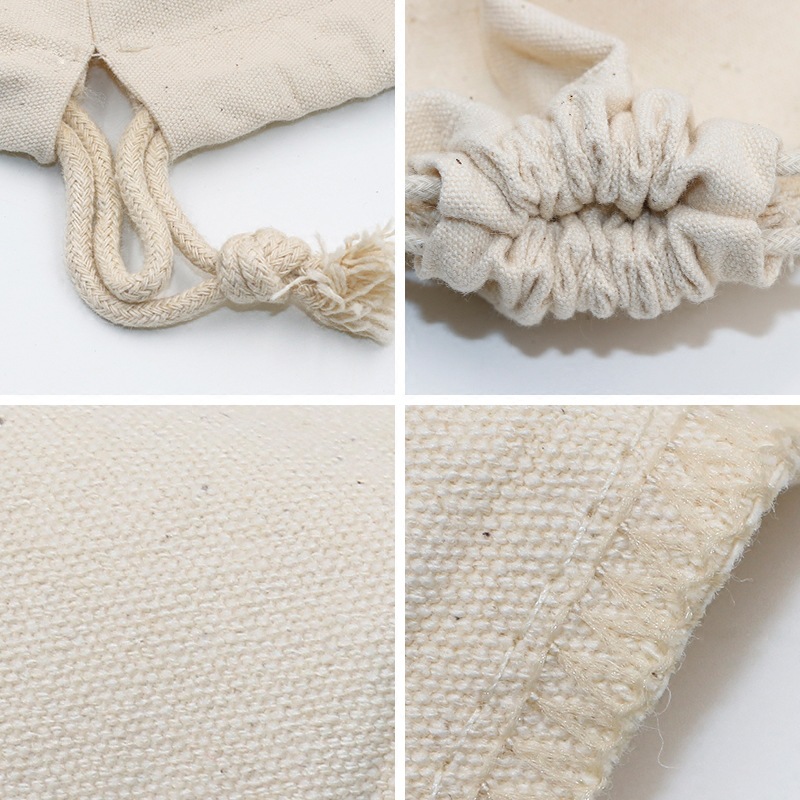How to Accurately Calculate Drawstring Length and Bag Opening Size
In the field of drawstring bag manufacturing, the compatibility between drawstring length and bag opening directly affects product functionality and user experience. The traditional rule of "twice the opening circumference" often leads to material waste or usability issues—excessively long cords may increase logistics costs by 5–12%, while cords that are too short cause up to 23% of customer complaints (according to industry survey data). After analyzing data from 3,000 pull tests, it becomes clear that a truly scientific drawstring length calculation must consider three core factors: fabric elasticity, knot length loss, and human grip comfort. This article presents a proven dynamic calculation system to help practitioners precisely balance functionality with cost, resolving the dilemma of "an inch too much is wasteful; a bit too short is tight."
Fundamental Principles
1. The Physics of Cord Movement
- Knot Loss Experiments: Comparison of cord length usage between square knots, butterfly knots, and slip knots (with diagrams).
- Friction Test Data: Pull resistance curves for different cord materials under wet and dry conditions.
- The Golden Bending Rule: Formula for calculating the extra bend length required for each grommet or eyelet.
2. Hidden Traps in Measuring the Bag Opening
- Sewing Shrinkage Reference Table (common fabric shrinkage rates post-sewing):
| Fabric Type |
Shrinkage After Sewing |
| Canvas |
3%–5% |
| Polyester |
1%–2% |
| Nylon |
0.5%–1% |
- 3D Opening Measurement Method: Special techniques for round bottom, square bottom, or irregular base bags.
3 Common Calculation Mistakes
(Common pitfalls clients often encounter)
- Blind Doubling
- For example, using 100 cm of cord for a 50 cm bag opening—resulting in insufficient length once tied.
- Ignoring Fabric Thickness
- A canvas bag and a nylon bag of the same size will require different cord lengths due to thickness "eating up" more length in canvas.
- Overlooking Use Case
- A fruit-carrying bag and a sports bottle holder require different tension levels, impacting the ideal cord length.
Smart Calculation Module
1. Simple Workshop Formula (Trusted by Veteran Craftsmen)
Total Cord Length = (Bag Opening Circumference + Functional Length) × Adjustment Coefficient
- Opening Circumference: Measured after stitching (not the raw cut fabric).
- Functional Length:
- Hand-carry style: Add 15 cm per side for tying.
- Shoulder-carry style: Add 40 cm on one side for adjustment.
| Material Type |
Coefficient |
| Cotton/Fabric Cord |
1.8× |
| Nylon Cord |
1.5× |
| Polyester Braided |
1.3× |
- Example:
- For a canvas shopping bag with a 60 cm stitched opening, using cotton cord for hand-carry:
- (60 + 15×2) × 1.8 = 162 cm
2. Advanced Dynamic Formula
- Total Cord Length (L) = [Base Length × (1 + Fabric Shrinkage Rate)] + Functional Segment + Safety Margin
- Base Length = Net opening circumference × Diameter Compensation Factor
- (Add 5% length for each 1 mm increase in cord diameter)
- Functional Segment Reference Table:
| Use Case |
Recommended Single Side Length |
| Wrist Carry |
8–10 cm |
| Shoulder Sling |
25–30 cm |
| Crossbody |
45–50 cm |
- Safety Margin: Adjusted for age group (children’s bags: reduce by 15%).
3. Material Compatibility Database
Coefficient of Friction Table (Save this for reference):
| Cord Material |
Cotton Fabric |
Polyester Fabric |
PVC-Coated Fabric |
| Cotton Cord |
0.22 |
0.18 |
0.35 |
| Nylon Cord |
0.15 |
0.12 |
0.28 |
| Blended Cord |
0.19 |
0.16 |
0.31 |
4. Production-Grade Error Control
- Cutting Tolerance Standard: ±0.5% (for cords >2 meters, measure in segments).
- Heat-Setting Compensation: PLA cords require 3 cm extra per meter.
- End Cap Consumption: Heat shrink tubing uses 1.2 cm per end.
Special Design Tips
- Drawstring for Kids’ Backpacks
- Limit total length to 75 cm (to prevent entanglement); use anti-slip wooden beads at cord ends.
- Square-Bottom Storage Bags
- Measure opening along the diagonal (e.g., 30×40 cm bag = ~50 cm circumference).
- Waterproof Coated Bags
- Increase cord length by 10% to compensate for higher pull friction.
Quick Reference Table
(For direct use in production)
| Bag Opening Size |
Cotton (Hand Carry) |
Nylon (Shoulder Style) |
Polyester (Closure Bag) |
| 40 cm (Round) |
1.3 m |
1.6 m |
0.9 m |
| 55 cm (Square) |
1.8 m |
2.2 m |
1.2 m |
| 70 cm (Large) |
2.4 m |
3.0 m |
1.6 m |
Real-World Case Studies
Case 1: Optimizing Fruit Bag Cord Length
- Original: 120 cm polyester cord (18% complaint rate)
- Improved: 108 cm frosted cord + silicone anti-slip stopper (complaint rate dropped to 2%)
Case 2: Outdoor Emergency Kit Anti-Theft Design
- Used crisscross threading + magnetic lock; reduced cord length by 20% while maintaining sealing integrity.
3.2 Customization for Special Needs
- Disability-Friendly Design: Vibration-sensing cord ends + enlarged scale markers.
- Food-Safe Option: FDA-certified silicone cords with compensation for length expansion.
FAQ – Customer Concerns
Q: Can the drawstring be adjustable?
A: Recommend an "asymmetric design" (e.g., 120 cm + 80 cm) for cost-saving and easy adjustment.
Q: What if the drawstring ends keep unraveling?
- A: Three common solutions:
- Heat-sealing (cost-effective)
- Metal cord tips (premium look)
- Braided finish (best for handmade styles)
Q: The drawstring keeps slipping out—how to fix?
- A: Focus on two key details:
- The grommet should be 2 mm wider than the cord diameter.
- Add a reinforcement stitch 3 cm below the opening.
Conclusion
Precise control of drawstring length is a fusion of technical calculation and practical craftsmanship. From base measurements to dynamic compensation, a three-level understanding is essential:
- Use the stitched circumference as the bag opening size, accounting for fabric shrinkage.
- Cord material and use scenario determine key adjustment coefficients—canvas with nylon cords may require 8–15% more length than polyester setups.
- Safety standards must not be overlooked—children’s products should strictly adhere to a 75 cm maximum.
In production, we recommend the “three-stage validation method”: sample grip testing, fatigue pull trials before mass production, and slippage inspection before shipment. Mastering these techniques can not only enhance product reliability but also save up to 200 meters of cord per 1,000 bags—providing a solid technical anchor for quality upgrades in drawstring bag manufacturing.




 We like to do design according to all the customers' requirements, or offer them our new designs. With strong OEM/ODM capabilities, we can fill your sourcing demands.
We like to do design according to all the customers' requirements, or offer them our new designs. With strong OEM/ODM capabilities, we can fill your sourcing demands.